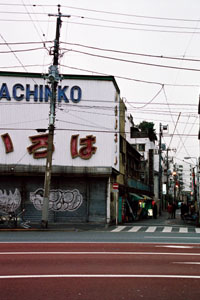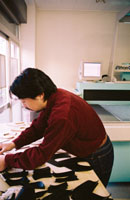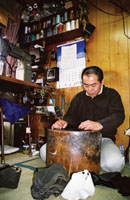In Depth: Will the Slum Remain the Same?
Back to Contents of Issue: April 2004
|
|
|
|
by Ty Harvey |
|
|
Kigoshi is a 38-year-old craftsman who has lived and worked in San'ya for the past 10 years. He cuts shapes of leather for large shoe manufacturers in a 21st- century workshop that's spacious and well-organized, replete with the newest computers, newest software and one big ultra-modern machine he imported from Italy after several trips to research the shoe industry there.
The machine, the CAD CAM, cost him over $100,000. Unlike the machines that stamp out the same shape of leather over and over for the mass-production of low-priced shoes, the CAD CAM is designed to cut various shapes of leather for the production of small batches of high-end shoes -- something that not so long ago required human hands.
"Anywhere you go, you'll find a negative side and a positive side," he explains, trying to describe Tokyo's paradoxical blend of the ancient and the futuristic. "The existence of both brings balance."
The balance is there between Shibuya, in Tokyo's southwest, with its high-rise department stores and Luis Vuitton billboards and herds of giggling schoolgirls in a neon lap of luxury, and San'ya, in Tokyo's northeast, with its half-vacant blocks, littered streets and a thousand homeless men lined up in the park for their one free meal of the day.
And it's there between Kigoshi and others in the community who do work like his.
Consider Kazuo Nidaira, who lives and works only a handful of blocks away. Nidaira also works leather for large shoe manufacturers. In his tiny workshop, packed with pictures and tools, an old sewing machine and a striped squirrel in a cage, Nidaira sits on the floor and does almost all of his work by hand on a cherry wood stump. Nidaira has lived in San'ya all 53 years of his life and has done work for the shoe industry over two decades, but he's more eager to talk about the squirrel than anything else.
People like Kigoshi and Nidaira can be found throughout San'ya, but the area isn't known for its craftspeople and many entrepreneurs. Instead, San'ya is known as the home of Tokyo's day-laborers, a force that has seen little work and even less money since the Japanese economy stumbled a decade ago. In short: San'ya is Tokyo's slum.
"San'ya has a different soul, a different style," Nidaira explains. The community is tightly knit, he says, and much more down to earth than those found in most of Tokyo's vast neighborhoods.
"While the government of Japan has fought to hide what it considers to be its negative side," adds Kigoshi, "it has created social injustice. And that made a place like San'ya."
The guilt of blood
Centered around the small neighborhood of Nihonzutsumi, in Taito Ward, San'ya is not in guidebooks or on subway maps -- or any other maps at all. The area dates back to the Edo period (1600-1868), the last era of Japanese casteism. It was in the city's northeast that the "Demon's Gate" was believed to stand, where all evil spirits entered the city. The city's hinin, Japan's lowest caste, were made to live in the area and to do the labor forbidden by the Buddhist faith -- the butchering, the curing of skins -- so that the wealthy could have their meat and leather, leaving the "inhuman" with the guilt of blood on their hands.
Members of the lowest caste were forced to behead, crucify and incinerate over 200,000 criminals so that the hinin would become the object of the people's disgust -- while the shogunate ruled without fear of insurrection.
Today, the statue of Buddha built in the days of the Edo period to appease the souls of those dead criminals sits beside Minami-senju station, blocked from view by surrounding buildings at the former site of the execution grounds. A nearby crossroads still bears the name "The Bridge of Tears," where mourners and spectators crossed a now-dry creekbed on their way to see the convicts die -- the statue and street sign testatments to the sacrifices many were forced to make so that a handful could profit.
But such monuments also fuel prejudices that, in spite of the abolition of the old caste system, never died. These reminders mark San'ya as a buraku, an area deemed unclean by the bigoted because of its kinship with the underclass; an area considered by some to be unworthy of the health care and educational systems the rest of Japanese society enjoys, and a home to residents who, regardless of the true class of their ancestors, face discrimination by many Japanese today.
Hungry for a wage
While in many of the surrounding buraku areas the pain of the past gave way to the civility and prosperity of a new Tokyo, San'ya remained a haven for men hungry for a wage -- and often willing to kill another man to get it.
San'ya became a place where, before sunrise, men stood ready to riot if not given work, where there were drunken brawls in the streets after dark and the yakuza took a cut when money changed hands. The police wore plain clothes to avoid being killed. Two film directors did their best to capture it all in a documentary titled Yama, and were murdered for sticking their cameras and noses where the yakuza decided they didn't belong.
With San'ya's ambulances, men sleeping in doorways and bonfires big enough to warm forty hands or more, it's easy to forget about people like Kigoshi and Nidaira. But on nearly every block one can hear the faint sounds of machines sewing or stamping or grinding. In spite of the violence and prejudice San'ya has seen, the tradition of craftsmanship is still alive. At least for now.
Kigoshi tells me that the local shoe industry (the oldest and most common in San'ya) faces serious troubles of its own: "Because the recession in Japan has created a decrease in demand for our products, and because foreign suppliers can better compete with Japanese producers by making their goods cheaper than ours, local workshops are now in a very dire situation." Nidaira agrees. He has to do more and harder work to make ends meet. He works over 100 hours each week already. Even so, he says, there are times when "it just doesn't pay off."
Sitting at a tavern in the center of San'ya, patrons talk with the bartender about the changes they believe are bound to come, changes that would make life for the crafts-people impossible. The cheap property and restaurants that have helped to keep the local shoe industry on its feet are beginning to attract more and more students from the art college in nearby Ueno. The college is beginning to look at San'ya's rows of vacant storehouses as ideal places for student studios in this city of astronomical real estate prices.
Things of the past
The government of Tokyo has kicked the homeless out of places before, most notably in preparation for the 1964 Olympics. The beaten-down, good-hearted people, as Mr. Kigoshi refers to them, will lose their place to run to. And proposed changes would raise local prices so high that many of the working craftspeople of San'ya would also have to find new homes. San'ya would lose the community that has been its sole source of stability for decades, and Tokyo would lose a critical source of its centuries-old balance.
Kigoshi is already amazed by the changes he's seen in the past 10 years. The police are back in uniform; the arson, the riots and the brawls in the streets are all things of the past.
But with his CAD CAM from Italy, Kigoshi says he's ready for the San'ya of the future. "To survive in the local shoe industry, manufacturers have to make lots of various high-quality products," he muses. He bought the machine so that he can work with the type of manufacturers that produce and sell for the modern world. Nidaira sees a different San'ya: "Nothing has changed, and nothing will." He will work and live in San'ya until the day he dies, he says. In his 53 years, he has watched many come and go. And in the end, he adds, San'ya remains the same because "friends always invite friends."
But if the city gets its way and San'ya is finally gentrified, some may come uninvited -- and they may not be so friendly.
@ |
|
Note: The function "email this page" is currently not supported for this page.


 "If San'ya were gone," Jin Kigoshi says of the Tokyo neighborhood around his workshop, "and if these beaten down, good-hearted people were to lose their place to run to, sooner or later they'd destroy Japan."
"If San'ya were gone," Jin Kigoshi says of the Tokyo neighborhood around his workshop, "and if these beaten down, good-hearted people were to lose their place to run to, sooner or later they'd destroy Japan."
 On my first trip to San'ya, I saw the vacant buildings, the crowds of homeless, and even though I wasn't sure that I was there, I was sure that I was close. So I asked a local shopkeeper where I could find it, and he pointed vaguely in one direction. I asked someone else, and she pointed in another. Later, I found out from a bartender down the street that I'd been in San'ya all along.
On my first trip to San'ya, I saw the vacant buildings, the crowds of homeless, and even though I wasn't sure that I was there, I was sure that I was close. So I asked a local shopkeeper where I could find it, and he pointed vaguely in one direction. I asked someone else, and she pointed in another. Later, I found out from a bartender down the street that I'd been in San'ya all along.
 This was San'ya until Japan's economy stalled in the 90s and the day labor market hit bottom. Layoffs throughout Japan created a new population of middle-aged homeless men unwelcome by the authorities in the cities they once called home. So they descended upon San'ya, where no one would harass them for being homeless.
This was San'ya until Japan's economy stalled in the 90s and the day labor market hit bottom. Layoffs throughout Japan created a new population of middle-aged homeless men unwelcome by the authorities in the cities they once called home. So they descended upon San'ya, where no one would harass them for being homeless.




